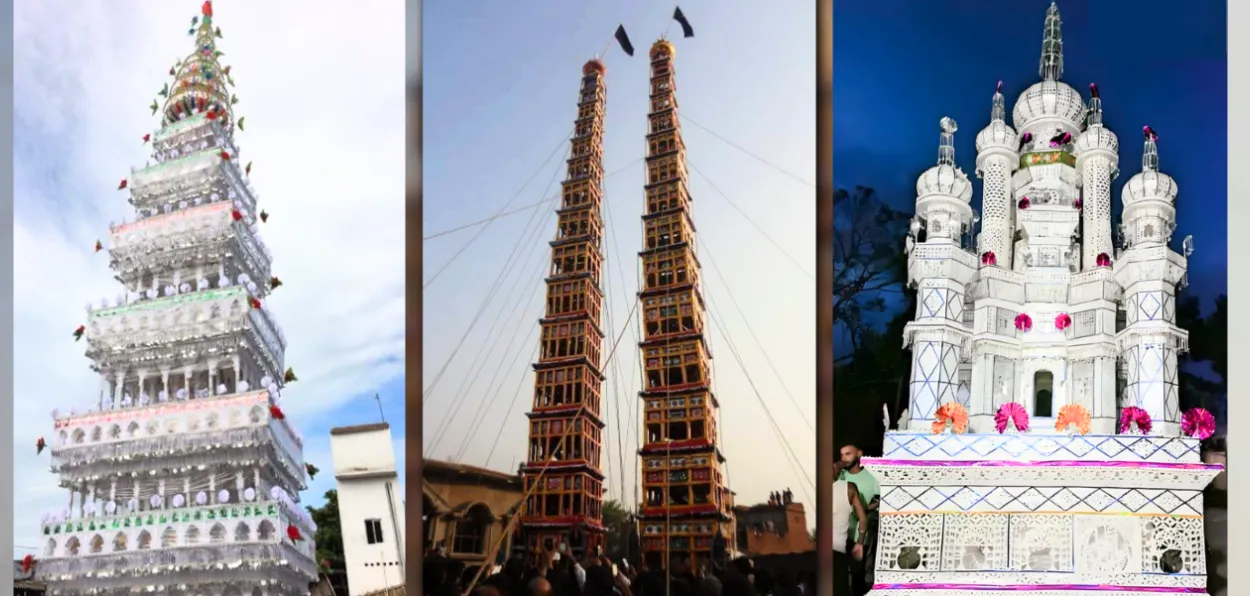
Rajiv Singh/New Delhi
Chunnilal and his brother Munnilal of village Bhikhapur, Siswan block of the Siwan district of Bihar, were childless. They made a living by selling tea and fried snacks at the roadside Koisk near the old post office in the village.
According to Dr. S.M. Zahid, a local some 70 years ago, Munnilal narrated his sorrowful story of being childless to the late Maulana Syed Rahat Hussain of Bada Imambara.
The Maulana advised him to visit Bada Imambara called Anjuman Abbasia and pray to the Divine. Imambara is a place for the burial of Taziya in memory of Imam Hussain, grandson of Prophet Muhammad who died in the War of Kabrala, central Iraq, on october 10, 680 AD.
He followed the advice and was blessed with a son. So was his brother Munnilal in the coming years.
Since that year this joint Hindu family has been ordering a Taziya, an icon martyrdom of Imam Hussain and his army of 72 warriors including women and children in the battle of Karbala, observed mainly by Shia Muslims all over the world as Ashura on the 10th day of month of Muharram.
.png)
A Taziya made by artisans of Bhikpur
The family keeps the Taziya on the threshold of their house as a sign of respect for the martyrs. The main procession of Ashura passes through their house. The mourners stop there to share their grief. Young members of the family pick their taziya and join the procession to the Imambara.
This year too, the main Ashura procession on July 17 will stop at the house of Chunnilal and Munnilal, the family members will carry their Taziya along with others to the Bada Imambara.
Surendra Prasad and Virendra, successors of Chunnilal and Mnnilal says that this tradition has been going on uninterrupted in the family.
Chunnilal and Munnilal are one of several Hindu families in the village who display their faith in the martyrdom of Imam Hussain and join the mourners and other commemorative rituals on Ashura. This makes the Ashura of this village unique and a living example of Hindu-Muslim unity.
Most of the local Hindus join Muharram the 10-day mourning with devotion and sincerity. Many other Hindu families living in the nearby villages of Chainpur and Nayagaon also follow this tradition.
Besides the Hindu-Muslim unity, the village Bhikhapur also boasts of flaunting the tallest of the Taziyas on Ashura.
.png)
Hindus and Muslims making Taziya
Bhikhpur village located on the banks of the river Daha has 350 to 400 houses and an equal proportion of Hindus and Muslims.
Locals say the tradition of taking out Taziya procession in this village is 195 years old and the event has always passed off peacefully.
At present, the making of big Tazias for the Ashura is in full swing in the village. One is being prepared under the aegis of Anjuman Abbasiya and the other at Anjuman Rejivia.
Anjuman Rejivia is making 80-feet Taziya for the Chota Imambara. In contrast, the one made for Bada Imambara Abbasi is four feet higher. The second one is approximately 16 stories tall. Artisans from both Hindu and Muslim communities work together on these.
Youths from the nearby village Bhikhpur also come to the village to help locals and also join the Taziya-making and mourning procession. Dr. S.M. Zahid says, “Imam Hussain raised his voice against evil. He sacrificed himself while fighting to save justice, humanity, and goodness.
“Even today his followers give this message through the Taziya that good always wins over evil. A man should follow the path of honesty and truth.” It is worth mentioning that Maulanas from outside and far-off places come to Bhikhpur for the Muharram Majlis.
.png) A taziya made in Bikhpur
A taziya made in Bikhpur
Another villager Syed Mohammad Rizvi says, “Before taking out the mourning procession and carrying the Taziya, people here take out the Alam, which is considered a symbol of Imam Hussain. A person carrying Alam leads the procession and is followed by the young, old, elderly, and children walking while performing the Zanjiri Matam (mourners inflict injuries on their bodies by beating themselves with iron chains.”
Locals have an interesting story about the possible clash between the traditions of Taziya and modernity. It happened some 25 years ago: the village was electrified and the officials came to install poles for the high-tension wires to supply electricity to each house. The locals pointed out that the electric poles and wires would obstruct the passage of the country's tallest Taziyas.
Since that year, the electricity department has been undertaking an elaborate exercise for this day. On Ashura Day, the officials disconnect the power supply to the village and disengage all the high-tension wires that could come in the way of India's tallest Taziya.
On the tenth day, villagers come out on the streets with Taziyas in the afternoon and reach Karbala before sunset.
ALSO READ: Young Scientist Muneer Khan runs an online portal for underprivileged innovators of India
Both Hindus and Muslims reach Karbala in a procession from the Imambara on the day of Muharram. During this, devotees offer batasha, laddu, malida, sherbet, khichdi roti, tilak, coconut, etc. on the Taziya. People from different parts of the country and abroad come to Bhikpur to participate in the Tazia procession.
